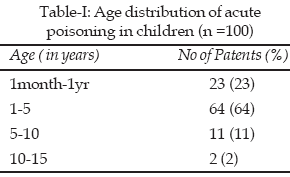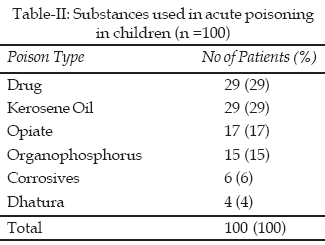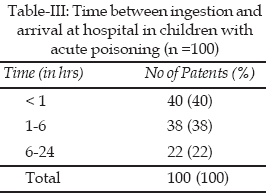|
 |
|
Published
by : PROFESSIONAL MEDICAL PUBLICATIONS |
|
ISSN 1681-715X |
|
|
|
|
|
- |
|
ORIGINAL
ARTICLE |
|
- |
|
Volume 25 |
April
- June 2009 (Part-II) |
Number 3 |
|
|
|
Pattern and frequency of acute
poisoning in children
Muhammad Aqeel1, Arshia Munir2, Afzal
Khan3
ABSTRACT
Objectives: To determine different agents involved
in acute poisoning in children, determine time interval between ingestion of
agent and report at the hospital and document its hospital outcome.
Methodology: This was descriptive case series study
conducted at the Department of Paediatrics (Emergency and General Wards),
Khyber Teaching Hospital, Peshawar from Jan 2007 to July 2007. A total
of hundred patients with history of acute poisoning were subjected to
detailed history and examination regarding different aetiological agents, time
interval between ingestion of agent and report at hospital and hospital
outcome.
Results: Majority of patients were below six years
of age, 69% were male while 31% were female. Pharmaceutical agents and
kerosene oil poisoning were the leading cause constituting 29% each followed
by opiate and organophosphorus constituting 17% and 15% respectively. Fifty
three percent of cases belonged to urban while forty seven percent belonged to
rural area. Forty percent of cases were brought to the hospital within first
hour; followed by 38% and 22 % in 1-6 and more than 6 hours respectively.
Ninety four percent of patients were discharged with almost complete recovery
while six percent expired during hospital stay.
Conclusion: Acute poisoning is an important
paediatric medical emergency and has got an important effect on morbidity and
mortality in this age group. Toddlers are the most prone group in
children to acute poisoning. Kerosene oil, drugs, organophosphorus and opiate
are the common aetiological agents of poisoning in children. Hospital outcome
is poor in patients with corrosives poisoning.
KEY WORDS: Acute Poisoning, Children, Kerosene oil,
Tricyclic antidepressants, Organophosphorus, Opiates.
Pak J Med Sci April - June 2009 (Part-II)
Vol. 25 No. 3 479-483
How to cite this article:
Aqeel M, Munir A, Khan A. Pattern and frequency of acute poisoning in
children. Pak J Med Sci 2009;25(3): 479-483.
1. Dr. Muhammad Aqeel Khan fcps
2. Dr. Arshia Munir, MBBS
3. Dr. Afzal Khan FCPS
1-3: CPSP, Hayatabad,
Peshawar.
Correspondence
Dr. Muhammad Aqeel Khan fcps
House No. 24, Street 2, Sector K4, Phase # 3
Hayat Abad, Peshawar. Pakistan
E-mail: khattakdr@yahoo.com
* Received for Publication: September 23, 2008
* Revision Received: March 13, 2009
* Revision Accepted: April 5, 2009
INTRODUCTION
Poisoning is defined as exposure of an individual to a
substance that can cause symptoms and signs of organ dysfunction leading to
injury or death.
1
Poisoning has been identified as one of the major causes of the childhood and
adolescence hospital emergency presentations and admissions in most developed
countries including the United States, United Kingdom, and Australia.2,3
Poisoning may be acute or chronic. In acute poisoning
symptoms suddenly appear soon after the suspected food, medicine or fluid has
been taken. The person, previously known to be in good health, is affected
with a group of symptoms which do not confirm to ordinary illness. In chronic
poisoning, symptoms develop insidiously and gradually. There is remission or
even complete disappearance of symptoms on the removal of the patient from his
usual surroundings.
4
In developing countries, poisoning has also been recognized
as a major health problem among children as adolescents.
4
Accidental poisoning is implicated in about 2% of all injury deaths in
children in developing countries.5
Certain poison types of medicinal and non-medicinal
substances have been identified as common agents in poisoning in children as
adolescents.
6
Riordan et al reviewed the literature on childhood poisoning and identified
several groups of medicinal substances as the most common.7
These included analgesics, anti-inflammatory agents, psychotropic drugs such
as antidepressants, and benzodiazepines related agents.8
Non-medicinal substances chemicals such as organophosphates, pesticides,
insecticides, organic solvents, and household such as bleach and caustics were
also found to be common causes of poisoning among children.9
Acute childhood poisoning is important because it is an
important cause of morbidity and mortality in children, which can be
significantly and affectively controlled by preventive and educational
measures.
10
The accidental exposure of a toxic substance by a child represents a complex
interplay of host, agent and environmental factors.1
Host factors associated with unintentional poisoning include young age
(preschool), male sex and curious, impulsive personality,11-13
whereas intentional poisoning is common in female sex and adolescent.12
It has also been suggested that there is a differential
relationship between poison types and geographic locations where poisoning
incidences occur.
3
Assumption on exposure, which is based on accessibility to poisonous
substances, leads to the hypothesis that certain types of poisoning would be
more prevalent in specific geographic locations. For example, children and
adolescents in rural areas would have more chance of exposure to agricultural
and other chemicals, hence poisoning due to these types of substances should
be more prevalent in rural areas. Drugs, pesticides and kerosene oil are
amongst the common etiological agents causing acute poisoning in children.14-16
The main agents causing death are caustics.17
Poisoning in children is an important health problem, which
has significant cost, both financial and emotional, as it is largely an
accidental phenomenon. It is also a prime target for prevention and cost
saving measures. Accidental poisoning constitutes a major cause of mortality
and morbidity in children in developing countries. To characterize poisoning
in children, a composite picture can be built from a number of the surveys of
Accident and Emergency (A&E) department and hospital admissions. The purpose
of this study was to determine the pattern and frequency of various agents
involved in acute poisoning in children, time interval between ingestion and
arrival at hospital and hospital outcome.
METHODOLOGY
This descriptive case series study was conducted at the
Department of Paediatrics (Emergency and General Paediatric wards), Khyber
Teaching Hospital Peshawar from January 2007 to July 2007. A total number of
hundred children, age one month to 15 years presenting with definite history
of exposure to toxic substances or clinical features suggestive of possible
poisoning were included in the study. Children with insect bite and
chronic poisoning were excluded.
All children were subjected to detailed history regarding
demographic data (age, sex and region), aetiological agents (like kerosene
oil, organophosphorus and drugs etc), time of poison ingestion, time of
arrival at hospital and hospital outcome. All the information was documented
on proforma. Complete general physical examination and thorough systemic
examination was performed in all cases. Investigations like complete blood
count, X-Ray chest, blood glucose, blood urea and creatinine, arterial blood
gases and toxicological screening of (gastric lavage, urine and blood) were
carried out, where needed. Specific management measures like gastric lavage,
decontamination, antidote, alkalization or diuresis were taken accordingly.
Outcome was measured in term of complete recovery and expiry. Informed consent
was taken from parent’s relatives and advantages/risks in study and
significance of the study were explained to the parents/relatives.
The data collected was analyzed using SPSS version 10
software. The age distribution of the patients was done by making different
age groups, like 1
st,
2nd,
3rd
and 4th
and putting patients into these age groups.
Descriptive Statistics was used to calculate Mean and
Standard Deviation of age. Frequency (%) was calculated for gender, rural /
urban distribution, type of poisoning and outcome. The data was presented as
tables and figures.
RESULTS
A total number of hundred patients with history of acute
poisoning were included in the study. Out of these hundred patients majority
were male constituting 69% patients of the study (n =69), while the remaining
31% were female (n =31), with an overall male to female ratio of 2.2: 1.0.
Maximum number of patients presented in the first five
years of life i.e. 87% (n= 87). Out of these majority were in the age group of
1 to 5 years of (n=64, 64%), followed by less than one year age group (n =23,
23%). While the rest of the patients 11% (n=11) and 2% (n=2) of cases
presented in 5 -10 years and 10-15 years of age groups respectively. The data
for age distribution is given in Table-I.

The age range was one month to 12 years, with a mean value
of 3.0292 and standard deviation of ± 2.5687. The region distribution of the
study showed that patients from urban area outnumbered that of rural area.
Patients from urban area constituted 53% (n= 53) while rural area constituted
47% (n=47) of cases.
Regarding the pattern and frequency of various poisons
Kerosene Oil and Drug category were the most common constituting 29% (n=29)
each. The common agents included in the drug category were tricyclic
antidepressants and analgesics. The rest of the agents were Opiate,
organophosphorus, corrosives and dhatura constituting 17, 15, 6 and 4%
respectively. The details regarding the pattern and frequency are given in
Table-II.

Seventy eight percent (n= 78) of cases were brought to the
hospital within the first six hour of poison ingestion, while the rest 22
percent (n= 22) arrived after six hour of ingestion as given in Table-III.
Ninety four percent of cases (n= 94) recovered completely during the hospital
stay while the rest six percent (n= 6) expired. P value for time and outcome
was 0.025.

Discussion
Acute poisoning is a common problem in pediatric age group.
Majority of the children (87%) in our study were less than five years of age.
This has been observed in other studies.
10,18,19
Mean age was three years in our study as compared to 2.48 by Hamid et al study
conducted at Children’s Hospital, Lahore.10
Male patients outnumbered female
patients in our study; the same was the case in studies conducted at National
Poison Information Centre, All India Institute of Medical Sciences, New Delhi
and Kuwait.20,21
The urban to rural patient ratio in our study was not much
different. About 53 percent of our population was from urban area while the
rest 47 percent from rural area. This was different from other studies
conducted at Lahore, India.
10,21
This may be due to the situation of the teaching hospital which is draining
both rural and city area almost at the same ratio, because almost all patients
included under the heading of rural area were from the surrounding peripheries
of the Khyber Teaching Hospital.
We have observed that pharmaceutical products as a group is
the most common cause of the childhood poisoning constituting 29 percent of
the patients. This is not different from other national and international
studies.
6,11,19
A report from India showed very high incidence 66.6 percent of drug poisoning.
Other studies have also shown drugs to be very important cause of poisoning
but not the leading one.
As far as individual pharmaceutical agents are concerned,
tricyclic antidepressants were the leading cause of poisoning in our study.
This reflects the magnitude of indiscriminate use of antidepressant agents in
our setup. Studies from United Kingdom in 1960 and 1970 showed antidiarrheal
drugs like lomoil and diphenoxylate as one of the leading causes of accidental
poisoning in children a trend which since then has shown significant decline.
22
The frequency of Kerosene oil poisoning was the same as
pharmaceutical agents constituting 29 percent of the patients with acute
poisoning in children. Many other local and regional studies show almost
similar results.
6,18,20,21
This is largely due to widespread use of kerosene oil as household fuel in
this part of world. It is found to be improperly stored in the kitchen
especially in soft drink bottles. Some studies show decline in Kerosene oil
poisoning because of increasing availability of other fuels.23
The frequency of opiate and organophosphorus poisoning was
17 and 15 percent in our study. A study conducted at Children’s Hospital and
the Institute of Child Health, Lahore showed frequency of 09 and 06 percent in
opiate and organophosphorus poisoning respectively.
10
Most of the patients 78 percent arrived in the first six
hour after ingestion of the poisonous agents. The patients reach at time to
our hospital probably because of its easy approach to its catchment’s areas.
Delay in the rest of almost one fifth cases is due to the ignorance of the
attendants.
Poisoning related mortality in paediatric population has
been reported from as low as 0.8% to as high as 12.5% in different studies.
9,21,22
In our study the mortality was 6% which is even lower than other local studies
which showed the mortality of 8% and 11% respectively.6,10
The reason for this low mortality may be situation of our hospital which is
easily approachable to its catchment’s area (urban as well as rural area).
Corrosives were found to be the leading cause of mortality in our study; same
result has also been shown by other international studies.17
A study from Ahwaz Iran reported 71% poisoning cases in
children between 1-5 years of age. In this study accidental ingestion was the
cause in 77.8% while suicidal attempt accounted for 6.2%. The most common
ingested substance was petroleum products (16%) Alkaline cleaners (12.6%),
Opiates(11.9%) tricyclic antidepressants (8.4%) and benzodiazepines (7.7%).
24
However in our study the Tricyclic Antidepressants were the leading cause of
poisoning which is similar to the substance abuse in Ahwaz study if we combine
poisoning due to TCAs and Benzodiazepines.
CONCLUSIONS
Acute poisoning is an important paediatric medical
emergency and has got an important effect on morbidity and mortality in this
age group. Toddlers are the most vulnerable group in children to acute
poisoning. Kerosene oil, drugs, organophosphorus and opiate are the common
aetiological agents of poisoning in children. Hospital outcome is poor in
patients with corrosives poisoning
REFERENCES
1. Osterhoudt KC, Shannon M, Henretig FM. Toxicological
emergences. In: Fleisher GR, Ludwig S (edi). Textbook of Pediatric Emergency
Medicine 4th ed. Philadelphia: Lippincott William & Wilkins, 2000;887-97.
2. Litovitz TL, Klein-Schwartz W, Rodgers GC. Annual report
of the American Association of Poison Control Canters Toxic exposure
Surveillance System. Am J Emerg Med 2002;20:391-452.
3. Reith DM, Pitt WR, Hockey R. Children poisoning in
Queensland: and analysis of presentation and admission rates. J Paediatr Child
Health 2001;37:446-50.
4. Parikh CK. Clinical and Forensic Toxicology: In Parikh’s
Textbook of Medical Jurisprudence, Forensic Medicine and Toxicology 8th ed
2006;8:1-10.77.
5. London L, Baillie R. Challenges for improving
surveillance for pesticide poisoning: policy implications for developing
countries. Int J Epidemiol 2001;30:64-70.
6. Aslam M, Baloch GR, Hussain W, Malik A, Haider A.
Accidental poisoning in children. Pak Ped J 2002;26:67-70.
7. Riordan M, Rylance G, Berry K. Poisoning in
children1‘1‘. Arch Dis Child 2002;87:397-9.
8. James LP, Abel K, Wilkinson J. Phenothiazine,
butyrphenone, and other psychotropic medication poisonings in children and
adolescents. J Toxicol Clin Toxicol 2000;38:615-23.
9. Lam LT. Childhood and adolescent poisoning in NSW,
Australia: An analysis of age, sex, geographic and poison types. Inj Prev
2003;9:338-42.
10. Hamid MH, Butt T, Baloch GR, Maqbool S. Acute poisoning
in children. J Coll Physicians Surg Pak 2005;15:805-8.
11. Chatsantiprapa K, Chokkanapatik J, Pinpradit N. Host
and environmental factors for exposure to poisons: A cross sectional study of
preschool children in Thailand. Inj Prev 2001;7:L 214-17.
12. Hon KL, Ho JK, Leung TH, Wong Y, Nelson EA, Fok TF.
Review of children hospitalized for ingestion and poisoning at tertiary
center. Ann Acad Med Singapore 2005;34:356-61.
13. Ali MA, Kichi QK, Sharif N. Acute poisoning in children
reported at B.V.Q / Quaid-i-Azam Medical College, Bahawalpur. Pak Ped J
2000;24:65-7.
14. Ahmed R, Ahad K, Iqbal R, Muhammad A. Acute poisoning
due to commercial pesticides in Multan. Pak J Med Sci 2002;18(3):27-31.
15. Dippenaar R, Diedericks RJ. Paediatric organophosphate
poisoning- a rural hospital experiences. S Afr J 2005;95:678-81.
16. Babar MI, Bhat RA, Cheema ME. Kerosene oil poisoning in
children. J Coll Physicians Surg Pak 2002;12:472-6.
17. Ulmeanu C, Nitescu Girnital VG. Mortality rate in acute
poisoning in a pediatric toxicology department. Przegl Lek 2005;62:453-5.
18. Khandwala HE, Kara AY, Hanafi IA, Yousuf K, Nizami SQ.
Accidental poisoning in children in Karachi, Pakistan. Pak Ped J
1997;21:159-62.
19. Izuora GI, Adeoye A. A seven-year review of accidental
poisoning in children. Ann Saudi Med 2001;21:13-5.
20. Akhtar S, Rani GR, Al-Anezi F. Risk factors in acute
poisoning in children-A retrospective study. Kuwait Med J 2006;38(1):33-6.
21. Dutta AK, Seth A, Goyal PK, Aggarwal V, Mittal SK,
Sharma R, et al. Poisoning in children: Indian scenario. Indian J Pediatr
1998;65:365-70.
22. Fraser NC. Accidental poisoning deaths in British
children 1958-57. BMJ 1980;280:1595-8.
23. Ab Rahman AF. Drugs and chemical poisoning admissions
at a teaching hospital in Malaysia. Hum Exp Toxicol 2002;21:377-30.
24. Assar S, Hatami S, Lak E, Pipelzadeh M, Joorabian M. Acute poisoning in
children. Pak J Med Sci 2009;25(1):51-54.
HOME
| SEARCH
| CURRENT
ISSUE | PAST
ISSUES
Professional
Medical Publications
Room No. 522, 5th Floor, Panorama Centre
Building No. 2, P.O. Box 8766, Saddar, Karachi - Pakistan.
Phones : 5688791, 5689285 Fax : 5689860
pjms@



